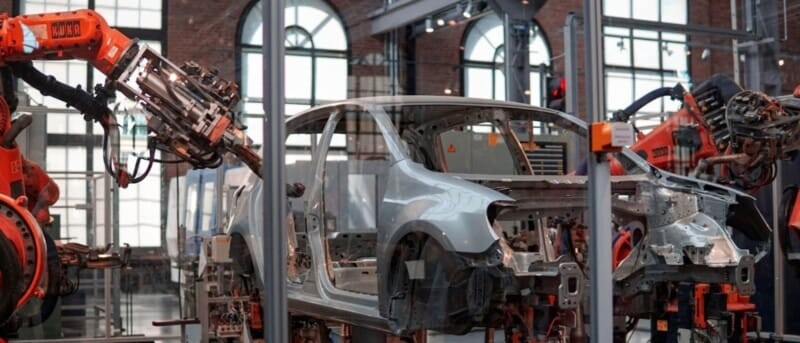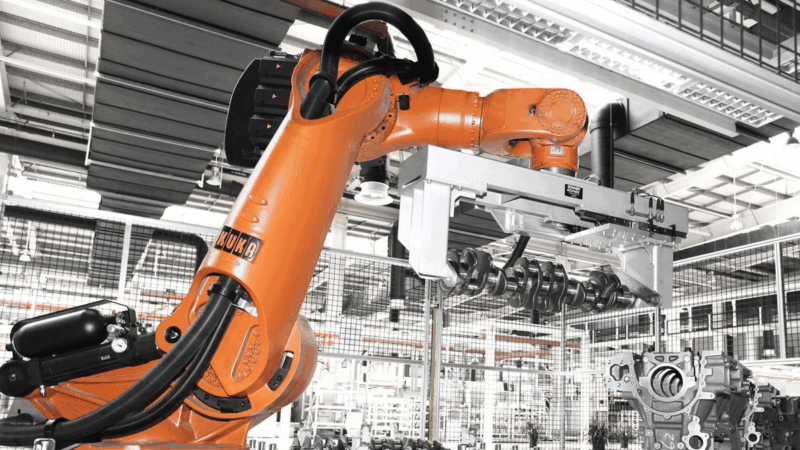
Factories of the Future: Powered by 3D Printers and High Performance Materials
Compared to traditional manufacturing methods, industrial 3D printing has provided numerous benefits for manufacturers— such as reducing costs and supply chain risk, making it easier and more economical than ever to build tooling, allowing for more iterations in design cycles, and enabling customers to solve problems directly at the point of need. With the Digital Forge’s proprietary Continuous Fiber Reinforcement (CFR) technology, users can print strong, lightweight functional parts out of composites that are capable of replacing metal parts.
For factory settings, the introduction of a large-format industrial 3D printer, capable of printing high-performance materials with CFR for added strength, not only unlocks familiar applications on a larger scale, but opens up a range of new uses and benefits for production-ready environments, such as:
- Automation — end of arm tooling, sensor brackets
- Continuous improvement — covers, ergonomic trays
- Tools and fixtures — assembly fixtures, custom hand tools
- Finish components — mounts, covers, plugs, handles, bumpers
When Bigger is Better
Industrial 3D printers come in various sizes and speeds. While smaller industrial 3D printers may be sufficient for printing smaller parts at lower volumes, having access to the size and power of a large-format printer offers many benefits for manufacturers:
Improved speed, accuracy — powerful large-format industrial 3D printers can print parts significantly faster than smaller 3D printers. Compared to our smaller composite Markforged 3D printers, our newest flagship printer, the FX20, is capable of printing 8x faster than stock settings and 2x faster than maximum speed.
Furthermore, large-format printers like the FX20 house far more sensors than smaller industrial 3D printers. Parts will not only be printed faster, but with superior accuracy, reliability, and quality.
Print smaller parts concurrently — smaller parts can be printed concurrently in batches, as opposed to individually, saving significant amounts of time for high-volume printing. With reliable large-format printers, AM use can be scaled up to meet the demands of production environments.
Consolidate multi-part print and assembly — fabricating large parts in single print jobs, as opposed to assembling several smaller components together, saves manufacturers significant amounts of time.
For many common industrial print applications, such as large bending dies, bed size is not enough for single-piece prints. Without a large-format 3D printer, these pieces require additional time and effort to 1.) split up the part into separate designs with a plan for assembling, 2.) initiate multiple print jobs, and 3.) piece together the components into the final functional part.

Large parts built stronger — with a bigger print bed, single-piece prints with longer CFR paths can be printed. Large, aluminum-strength parts can be reinforced with continuous fiber from end to end. Parts that require multi-component assembly will contain gaps in the continuous fiber reinforcement.
High temperature material availability — larger industrial 3D printers like the FX20 are able to print in a wider range of high-temperature composites, such as ULTEM 9085™ Filament, Onyx™ FR, and Carbon Fiber FR. The FX20 is the only 3D printer capable of printing these high-performance materials with added strength from Continuous Fiber Reinforcement (CFR).

Materials for Demanding Factory Applications
When choosing materials for applications in manufacturing facilities, it is critical that materials maintain strength while operating in high temperatures. Using high-performance materials such as ULTEM 9085™ Filament, applications in paint curing booths, parts washers, and autoclaves are great candidates to be 3D printed. The ability to print in strong, high-temperature materials can eliminate the need to machine these parts from metals or plastics.
Materials with the right dielectric properties can be an asset for high voltage applications, like bus bars made on our Metal X System out of pure copper filament that can be protected by conformal ULTEM™ 9085 Filament prints. This material uniquely provides strength at high temperatures where insulative properties are required. Furthermore, the chemical resistivity of ULTEM™ 9085 filament is suitable for applications that can withstand sustained exposure to ammonia, various industrial acids, hydrogen peroxide, and tar. The FX20 is the only industrial 3D printer capable of printing ULTEM™ 9085 with the added strength of continuous fiber reinforcement (CFR).
The low-weight, material properties, and high strength of ULTEM™ 9085 reinforced with continuous fibers also make it ideal for end-use parts in aerospace applications. With ULTEM™ 9085 Filament on the FX20, suitable flight-ready applications include:
- Interior components — wall panels, cabinet doors, latches, spare parts
- Behind the walls — ducting, housings, connectors, brackets
- Finish components — enclosures, mounts, plugs, handles, bumpers
Software Automation
With software like Eiger™, printers at each factory can function as plug-and-play boxes that quickly produce the right parts when needed, without demanding significant attention or local additive manufacturing expertise. That’s possible because each printer can be managed and controlled by a remote central team using Eiger™ Fleet and BlacksmithTM to ensure appropriate access, device operation and part versions and quality.
Integrations on the Digital Forge make it possible for part production to be initiated by requests in each factory’s core systems — through a Manufacturing Execution System (MES), Enterprise Resource Planning (ERP) or Enterprise Asset Management (EAM) — or by scanning the barcode of a physical part that needs to be duplicated. Blacksmith verifies that a printed part is immediately usable in the factory, automatically generating part quality and traceability reports.
**ULTEM™ and 9085 trademarks are used under license from SABIC, its affiliates or subsidiaries.
All of the blogs and the information contained within those blogs are copyright by Markforged, Inc. and may not be copied, modified, or adopted in any way without our written permission. Our blogs may contain our service marks or trademarks, as well as of those our affiliates. Your use of our blogs does not constitute any right or license for you to use our service marks or trademarks without our prior permission. Markforged Information provided in our blogs should not be considered professional advice. We are under no obligation to update or revise blogs based on new information, subsequent events, or otherwise.
Never miss an article
Subscribe to get new Markforged content in your inbox